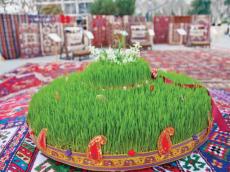|
|
TODAY.AZ / Society
Azerbaijanis welcome beloved Novruz holiday
23 March 2015 [10:45] - TODAY.AZ

/By AzerNews/
By Amina Nazarli
As spring has already graced many corners of the globe, Azerbaijan is getting ready to celebrate its most cherished holiday and favorite tradition - Novruz Bayram.
Azerbaijanis and many other people throughout the world are happy to meet the warm spring and forget all about the gloom of winter.
When the sun moves from the southern hemisphere to the northern hemisphere, the equinox takes place - equal hours of day and night. This marks the end of winter and the beginning of spring.
It is at that time that Azerbaijanis celebrate beautiful Novruz -- the first day of spring, the revival of nature.
Novruz, symbolizes the awakening of natural life and marks the end of an old year and beginning of a new year.
Being not a religious holiday, but rather a tradition, one dating back to Zoroastrianism, the oldest of the monotheist religions, it is the most beloved holiday of all Azerbaijanis.
The holiday is loved by both children and adults, as it is a celebration not only of the vernal equinox, but also equality, communion and unity. Novruz brings people of different backgrounds together, strengthening mutual respect and peace in society.
Novruz celebrations begin a month before the actual holiday, which is marked on March 20-21.
Preparation for the holiday begins with Water Tuesday, or as it is known here, Su Chershenbesi, following by Fire Tuesday (Od Chershenbesi), Wind Tuesday (Yel Chershenbesi) and Earth or Last Tuesday (Torpag or Akhir Chershenbesi).
The four Tuesdays are associated with the arrival of the new year and nature's rebirth and dedicated to the awakening of one of the natural elements.
People try to meet the holiday with clean houses, believing that “a good beginning makes a good ending." So, many people are busy with the tiding up of their houses and yards on the eve of the Novruz.
Almost every family in Azerbaijan will celebrate the holiday with green Semeni. It is some kind of ritual, which is usually accompanied with the song "Semeni, save me and I will grow you every year."
Long before the holiday, about two weeks earlier, people would have sown wheat or lentils on saucer. By the time the holiday arrives their green shoots reach 5-7 cm and become indispensable decorations on many tables.
As many holidays, this holiday is also impossible without a festive table. It is the day when all family members get together to meet the new year with fun and joy.
The required element of the festive table is khoncha, a big tray with semeni placed in the center, and candles and dyed eggs for each family member around it. Also "govurgha" (toasted wheat) is mixed with nuts (mainly walnuts, hazelnuts, almonds and chestnuts) and placed on the table along with other sweets.
Such attributes of Novruz table as pakhlava (baklava), shakarbura (a cookie with nuts and sugar wrapped in dough), and shorgogal ( layers of pastry flavoured with turmeric and fennel seeds) decorate almost all Azerbaijani tables. All these sweets are associated with star, half moon and sun, respectively, as their shapes remind these symbols.
A "King" of Azerbaijani cuisine "Plov" (Pilaf) is an indispensable guest on every holiday table, along with other national dishes. With more than 60 different kinds, this dish gives the table a festive mood.
Lighting bonfires is another integral symbol of Novruz, almost each yard kindles its own bonfire, with people happily jumping over it for seven times. People of all ages will join in the tradition, happily believing that the fire will purify and take away all their troubles.
“Relieve me of my troubles and misfortunes and bestow me much more joy" - they will say.
Novruz is also famous for its bright customs - such as placing hats at a door is probably the most favorite one among children. They enjoy knocking on neighbors’ doors and then hide, waiting with anticipation for the treats they will get.
Another interesting aspect of Novruz is its divination tradition. Mainly young unmarried girls will get together to know when they will get married or find out whether they will fulfil their dreams. Although people do not take this tradition seriously, they're still keen to keep the ancient ceremony alive, a link to the country's rich history.
Symbolic characters of Novruz are Kechel, Kosa and Bahar gizi (Spring girl). All of them have their feature: Kechel characterizes the period before the renewal of nature, Kosa is a symbol of fertility, while Bahar gizi represents the landscaping of nature.
On this day Azerbaijanis will not forget those less fortunate. They will make sure to send those with lesser means their holiday 'portion' or Novruz payi, so they can enjoy the sweetness of Novruz as well.
Happy Holidays!
URL: http://www.today.az/news/society/139342.html
 Print version
Print version
Connect with us. Get latest news and updates.
See Also
- 19 April 2024 [17:36]
Baku French High School discloses reason for suspension of activity - 19 April 2024 [13:36]
Heydar Aliyev-International Education Grant Program announced for 2024-2025 academic year - 18 April 2024 [20:10]
Ombudsman representatives attend Environmental Security & Green World Conference - 17 April 2024 [16:47]
OSCE acting chairperson to visit Azerbaijan - 17 April 2024 [15:34]
Employability Week held at ADA University - 17 April 2024 [14:56]
Azerbaijan to increase number of high schools, gymnasiums in all regions, says Minister - 16 April 2024 [14:53]
MoU on establishment of Turkiye-Azerbaijan University approved - 16 April 2024 [12:17]
Opening ceremony of "Caspian Basin Studies" program held at ADA University - 15 April 2024 [12:55]
Heydar Aliyev Foundation takes over former footballer Vadim Vasilyev's treatment - 15 April 2024 [10:00]
Earthquake hits Azerbaijan's Imishli district
Most Popular
 EU acknowledges strategic significance of Baku International Sea Trade Port in Middle Corridor
EU acknowledges strategic significance of Baku International Sea Trade Port in Middle Corridor
 Weapons & ammunition discovered in Khankendi
Weapons & ammunition discovered in Khankendi
 South Korea conducts live-fire exercises near borders of DPRK
South Korea conducts live-fire exercises near borders of DPRK
 Navigating challenges in Azerbaijan's trade turnover amidst global uncertainties
Navigating challenges in Azerbaijan's trade turnover amidst global uncertainties
 TikTok closed in Kyrgyzstan
TikTok closed in Kyrgyzstan
 Azerbaijan's AccessBank joins UN Global Compact
Azerbaijan's AccessBank joins UN Global Compact
 Rising fuel expenses signals economic challenges for Azerbaijan
Rising fuel expenses signals economic challenges for Azerbaijan
